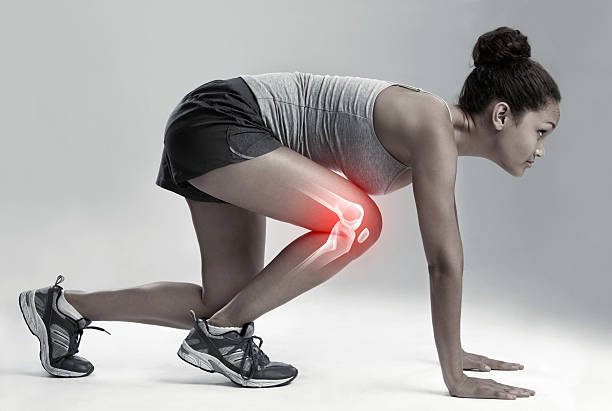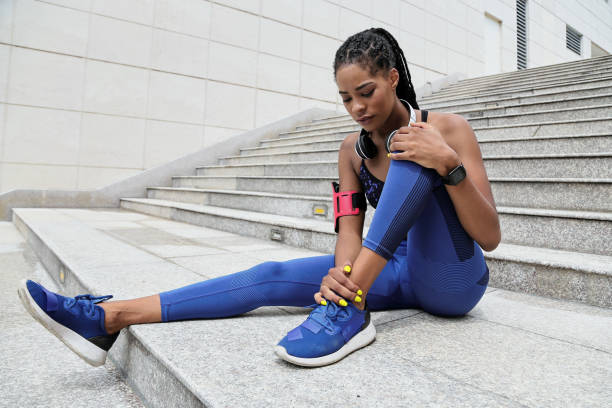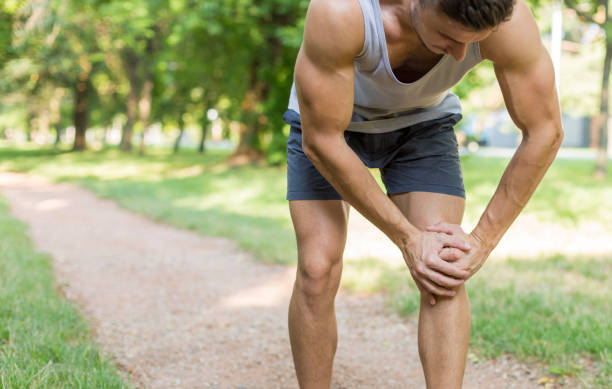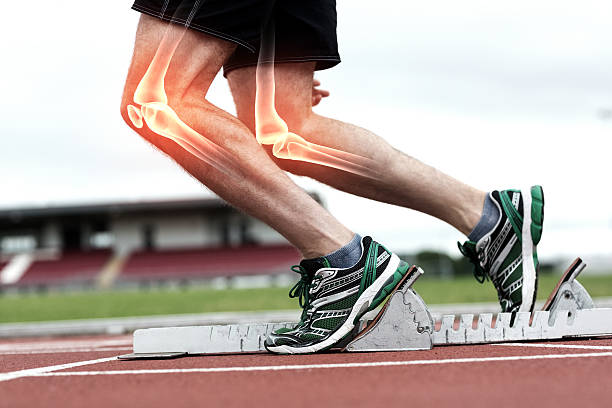Joint Health
How To Prevent Joint Pain When Running
Joint pain is a typical issue for runners, and it can make it difficult to enjoy the activity. Whether you’re a seasoned runner or just getting started, it’s critical to take precautions to avoid joint pain and maintain your body healthy. In this post, we’ll discuss several tactics for avoiding joint pain when running.
Wearing the appropriate shoes is one of the most important things you can do to avoid joint pain. Your shoes should be comfortable and supportive of your feet and ankles. Look for shoes that are specifically developed for running, and consider having them fitted by a professional to ensure the greatest fit. It’s also a good idea to replace your shoes every 300-500 miles to verify they’re still giving the necessary support.
Another important component in avoiding joint pain is to run with proper form. Keep your head up, shoulders relaxed, and arms at your sides. Over striding is prohibited, and your feet should land directly beneath your body. Maintaining proper form will lower the impact on your joints and reduce your risk of injury.

Understanding Joint Pain in Runners
As runners, we are aware that joint soreness is a regular problem while training. Inflammation is frequently the source of joint discomfort, which can be caused by a range of circumstances such as overuse, injury, or underlying disorders such as osteoarthritis.
Runner’s knee, also known as patellofemoral pain syndrome, is a prevalent type of joint pain experienced by runners. Overuse, muscular imbalances, or poor form can all contribute to this problem, which causes pain in the front of the knee.
Medial tibial stress syndrome, popularly known as shin splints, is another type of running ailment that can cause joint pain. Overuse, poor footwear, or running on hard surfaces can all contribute to this ailment, which causes pain along the shin bone.
While running can occasionally cause joint pain, studies have shown that distance running does not raise the risk of osteoarthritis of the knees and hips in healthy long-distance runners. Running, in fact, may be beneficial to our joints because it helps to build muscles and enhance general joint health.
To avoid joint pain when running, we must take care of our bodies by using good training techniques, wearing appropriate footwear, and including strength training activities into our routines. Furthermore, if we do feel joint discomfort, we should rest and seek medical assistance if the pain persists or worsens.
We may continue to enjoy the advantages of running while decreasing the risk of injury and joint pain by recognizing the causes of joint pain in runners and taking preventative steps.

Proper Running Form and Techniques
Maintaining appropriate running form is critical to avoiding joint pain when running. Whether you are a novice or a seasoned runner, it is critical to pay attention to your form to avoid putting undue strain on your joints. Here are some pointers on appropriate running technique and form.
Posture
Maintaining excellent running form requires good posture. Make sure your shoulders are relaxed and your back is straight. Slouching or leaning forward can put extra strain on your lower back and knees. Keep your head up and your gaze forward, rather than down at the ground.
Footstrike
Your joint health might also be affected by how your foot rests on the ground. Aim to land on your midfoot rather than your heel or toes. This helps to spread the impact of each stride more equally throughout your entire foot, reducing joint tension.
Cadence
The amount of steps you take per minute, or cadence, is a crucial aspect in optimal running technique. To limit the risk of joint pain and injury, aim for a cadence of 180-200 steps per minute. To assist you keep a steady cadence, utilize a metronome or a running app.
Stride Length
The length of your stride, or the distance between each step, can also have an impact on your joint health. Avoid overstriding or taking too long steps. This causes your foot to land in front of your torso, putting additional strain on your knees and hips. Instead, strive for a stride length that permits you to retain appropriate form and cadence.
Arm Swing
Finally, when jogging, your arm swing can have an impact on your joint health. Keep your arms loose and swing them at your sides freely. Crossing your arms in front of your body or swinging them too high might induce neck and shoulder stress.
You can lower your chance of joint pain and injury when running by following these guidelines for appropriate running form and tactics. To minimize overexertion, begin slowly and gradually increase your speed and distance.

Recommended Exercises and Training
When it comes to preventing joint pain while jogging, including specific exercises and training strategies into your program can assist improve your strength, flexibility, and balance. Here are some exercises and training approaches to consider:
Balance and Strength
Strength training can help you enhance your total muscle strength and lower your chance of injury. Exercises that focus your core, calf muscles, quadriceps, and hamstrings might be very beneficial for runners. Squats, lunges, and leg presses are all excellent exercises for increasing lower-body strength.
Balance exercises, in addition to weight training, can assist improve your stability and lower your risk of falls or accidents. Try standing on one leg for 30 seconds at a time, eventually increasing to a minute or more.
Stretching and Flexibility
Flexibility is essential for avoiding joint pain and damage during jogging. Stretching exercises can help you enhance your range of motion and eliminate stiffness. Dynamic stretching, which involves exercising your muscles through their complete range of motion, might be especially beneficial for runners.
Stretching exercises to try include hamstring stretches, calf stretches, and quad stretches. Remember to hold each stretch for at least 30 seconds and to avoid bouncing, which can cause injury.
Interval Training
Cross training entails mixing many forms of activities into your regimen, such as swimming, cycling, or weightlifting. This can help lower the risk of overuse injuries and enhance overall fitness.
Core strengthening activities, such as planks or crunches, can also be good for runners. A strong core can assist improve your posture and prevent joint pain while running.
Incorporating these workouts and training approaches into your regimen will help improve your strength, flexibility, and balance, lowering your chance of joint pain and injury when running. Always listen to your body and seek medical attention if you are in pain or discomfort.

Rest, Recovery, and Pain Management
Rest and rehabilitation are vital for preventing joint pain when running. Resting your body allows it to repair and recoup from the stress of running. Stretching, foam rolling, and other activities that aid in muscle recovery are examples of recovery.
Ice and heat can also help relieve joint pain. Heat can help enhance blood flow and promote healing while ice can help reduce swelling and inflammation. It is critical to follow the directions for these therapies and not overdo it.
Ibuprofen can help reduce inflammation and pain associated with joint pain. However, it is critical to use ibuprofen as advised and not as a long-term remedy. Sleep is also essential for pain relief and recuperation. Adequate rest can assist your body in healing and recovering from the stress of running.
In addition to these measures, it is critical to minimize swelling by resting and elevating the affected joint. Compression can also aid in the reduction of swelling and the promotion of healing.
You can help prevent joint pain and stay healthy by adopting these tactics into your jogging regimen. Always listen to your body and take pauses as needed.
Choosing the Right Running Gear
Choosing the appropriate running gear is critical for avoiding joint pain when jogging. This section will go over two critical parts of running equipment: footwear selection and supportive accessories.
Footwear Selection
The most significant piece of equipment for runners is unquestionably their shoes. Proper footwear provides the required support and cushioning to assist in the prevention of joint discomfort and other problems. When choosing running shoes, keep the following factors in mind:
- Fit: Running shoes should be snug but not too tight. Make sure your toes have adequate room to wiggle around in the toe box.
- Support: Look for shoes that give enough foot support. Consider arch support shoes if you have flat feet. Look for shoes with more cushioning if you have high arches.
- Cushioning: Running shoes should be cushioned sufficiently to absorb impact and prevent joint soreness. However, too much padding can be detrimental, so strike a balance that works for you.
- Breathability: To keep your feet from getting too hot and sweaty, look for shoes constructed of breathable materials.
It is also critical to update your running shoes on a regular basis. The majority of experts recommend replacing them every 300-500 miles or six months, whichever comes first.
Supportive Accessories
Other supportive devices, in addition to good footwear, can assist reduce joint pain when running. Here are a few examples:
- Orthotics: Custom orthotics can give additional support and cushioning if you have flat feet or high arches.
- Compression gear: Compression socks, sleeves, and shorts can help increase circulation and minimize swelling, thereby preventing joint pain.
- Supportive braces: Supportive braces can assist provide extra stability and support if you have a history of joint pain or injury.
In conclusion, selecting the proper running clothing is critical for avoiding joint pain when running. We can help keep our joints healthy and pain-free by wearing the right shoes and wearing supportive accessories.

Listening to Your Body
It is critical to listen to your body when it comes to preventing joint pain when jogging. We must recognize that running is a high-impact activity that places significant strain on our joints. It is critical to pay attention to our bodies’ signals and alter our jogging regimen accordingly.
Fatigue is one of the most common messages our bodies send us. It’s normal to feel exhausted after a long run or an intense workout. However, if we feel tired all the time, it could be an indication of overtraining. We must take a pause and allow our bodies to heal. To avoid weariness, it is also critical to have enough rest and sleep.
Soreness is another signal from our bodies. Muscle soreness is usual after a workout, but joint pain is distinct. If we have chronic joint discomfort, it could be a sign of an injury or inflammation. We need to stop running and allow our bodies to recuperate. Stretching before and after jogging is also important to avoid pain.
In conclusion, we must pay attention to our bodies in order to avoid joint pain while running. We should pay attention to our bodies’ cues, such as weariness and discomfort, and modify our running regimen accordingly. It is critical to get enough rest and sleep, stretch before and after jogging, and stop running if we have persistent joint pain.
Conclusion
In wrapping up our exploration of safeguarding joints during the rhythmic pursuit of running, it becomes evident that the joy of this activity need not be compromised by the specter of joint pain. Each stride is an opportunity to revel in the symbiotic dance between body and motion, and with mindful precautions, we can ensure that this dance remains harmonious.
For me, the commitment to preventing joint pain isn’t just about logging miles; it’s a pledge to the longevity and enjoyment of my running journey. Embracing proper footwear, incorporating strength training, and listening to the signals of my body have become integral parts of my running routine.
As fellow enthusiasts traverse the trails and pavements, it’s my hope that these insights serve as a companion in their running odyssey. Personalized adjustments, coupled with a proactive approach, can transform running from a potential source of discomfort to a flourishing avenue of health and vitality.


